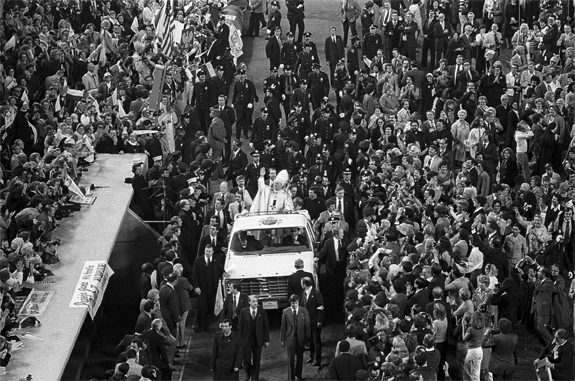

In the years preceding the Great Jubilee of 2000, John Paul II held a series of continental synods to help the Church in different locales reflect on its distinctive situation at the end of the second millennium, and to plan for a future of evangelical vigor in the third. These Special Assemblies were easily named in the case of the Synods for Africa, Asia, and Europe.
But when it came to the Synod for the western hemisphere, John Paul threw a linguistic curveball that made an important point.
It was expected to be called the Synod for the Americas. But at John Paul II’s insistence, it became the Special Assembly of the Synod of Bishops for America. As in America, singular. Why? Several reasons.
The pope believed that the western hemisphere had experienced a single, great “first evangelization,” when the Europeans crossed the Atlantic and planted the Cross from Quebec to Tierra del Fuego. Moreover, he thought that this first evangelization had a particularly powerful symbol and patroness in Our Lady of Guadalupe, whom John Paul often cited as the example of a “perfect inculturation” of the Gospel.
And then there was the future: John Paul hoped that, were the Church in the two halves of the Americas to think of itself as one, single “subject” of that first evangelization, it might be better prepared, spiritually and imaginatively, to undertake the new evangelization as a common enterprise.
All of this, and more, is beautifully captured in a new documentary from the Knights of Columbus—“John Paul II in America: Uniting a Continent.”
Those under 30, whose living memories of John Paul are of an old, enfeebled man, should watch this moving film to be reminded what an extraordinarily handsome, dynamic and compelling figure the Polish pope was in the first two decades of his pontificate, before the Parkinson’s began to erode his immense physical strength. Here is John Paul kissing and dandling babies, whooping it up with young people in Madison Square Garden, reaching out and embracing the halt, the lame, and the elderly—all of which helped make possible the new papal model that Pope Francis has lived to such effect.
And then there is John Paul II speaking truth to power: to visibly nervous representatives of communist governments at the United Nations in 1979; to Pinochet, Stroessner, the Argentinian junta, and other authoritarian abusers of human rights in Latin America; to the adolescent Sandinistas in Nicaragua when they tried to drown out his sermon in Managua with idiotic chants. The younger John Paul II was an exceptionally charismatic man. But unlike so many other leaders of his era, he never played the demagogue; the style was always in service to the substance he preached, which was Jesus Christ.
And then there is John Paul II, the mystic, celebrating Mass before crowds in the hundreds of thousands, even millions, yet withdrawing at moments inside himself, into that special place where he conducted his ongoing and intense dialogue with the Lord—only to re-emerge, magnetic as ever, to summon all of us to be the missionary disciples and saints we were baptized to be.
The World Youth Days John Paul celebrated in “America”—including his last one, in Toronto in 2002—get well-deserved attention in the film, for here was the pope demonstrating to the world (and to skeptical bishops) that young people want to be challenged to lead lives of heroic virtue, just as they want to know that the Church will be with them, offering reconciliation and mercy, when they fail to reach the mark—as we all do. The effects of those electric days are still being felt, decades later, among the liveliest parts of the Church in this hemisphere.
“John Paul II in America: Uniting a Continent” has already been shown on several local television stations. It would be well worth contacting your local programming director and asking him or her to consider airing this visually compelling, thought-provoking film, in preparation for Pope Francis’s visit to the U.S. in September.
If you value the news and views Catholic World Report provides, please consider donating to support our efforts. Your contribution will help us continue to make CWR available to all readers worldwide for free, without a subscription. Thank you for your generosity!
Click here for more information on donating to CWR. Click here to sign up for our newsletter.


